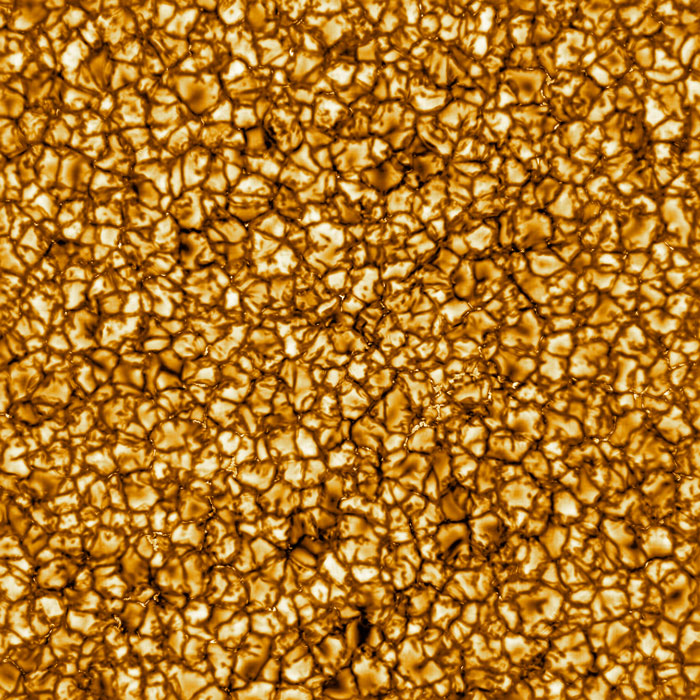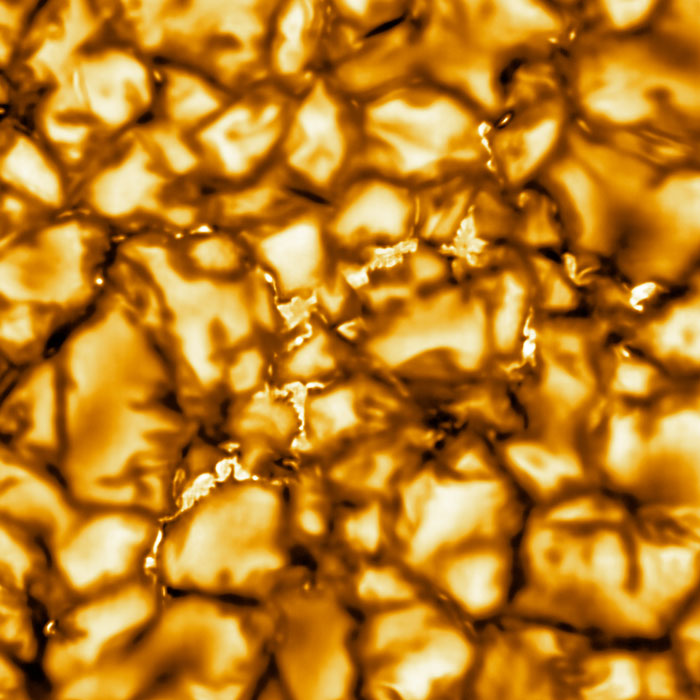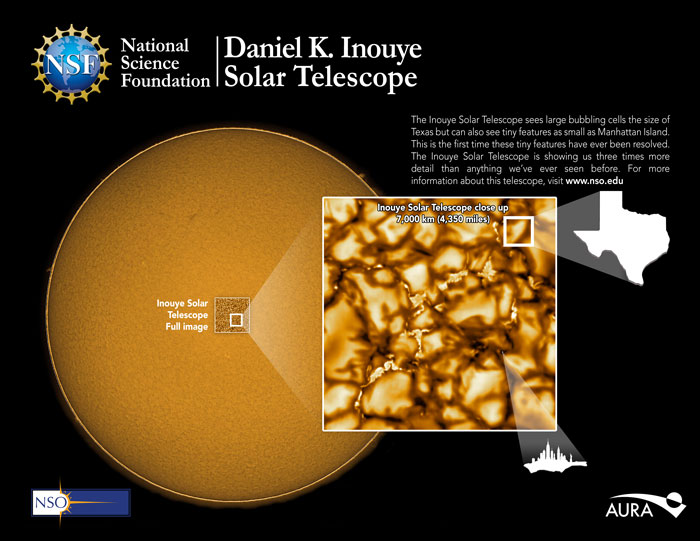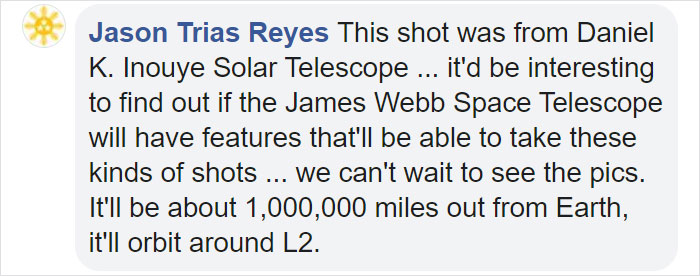
Science Gave Us A High-Def Close-Up Of The Sun’s Surface And People Are Seeing Things
The Sun is awesome. It has given us so many beautiful and amazing things that it simply can’t be called anything other than that.
Just think about it: it provides all of Earth’s living creatures with warmth, is a key part of the oxygen-making process, gives us marvelous sunrises and sunsets, makes stunning eclipses happen, and, on top of it all, is one of the sources of vitamin D and makes us happy (because serotonin).
Well, brace yourself because the Sun just got even cooler (awesomeness-wise, not temperature). Apart from it putting on a haunting face for Halloween, science has just released a handful of images and videos of the Sun and they are considered the highest resolution ever taken in the history of mankind. AND, it looks like caramel popcorn.
This is what the sun looks like after a closeup using the Inouye Solar Telescope
Image credits: National Solar Observatory
The National Solar Observatory (NSO), with whom Bored Panda got in touch for an interview, has recently published several photos and videos of the Sun’s surface snapped by the National Science Foundation’s Daniel K. Inouye Solar Telescope. It is currently making headlines for being the highest resolution imagery available and providing unprecedented detail of our most beloved star above.
At first glance, people seem to think that it’s a top-down view of caramel popcorn. And who can blame them? It certainly does look like it. However, as the NSO explained, it’s actually turbulent plasma “boiling” on the surface of the sun. These are powerful motions that transport heat outward from inside the star. This process is the reason behind the cell-like structure of the surface.
“This footage shows a small section of the Sun’s surface. Small is relative of course—this patch is about 16 times the size of the whole planet Earth (for the less zoomed image),”explained Claire Raftery of the NSO Outreach and Communications Team. “The large bubbling cells are called granules, and are the tops of huge bubbles of gases rising from inside the Sun, much like a pot of boiling water. Gases inside the Sun get heated up and rise to the surface, where they cool off and get pushed back downwards again.”
She continued: “The downward moving gas appears dark, and that’s what is happening in the dark lanes between the cells. Sometimes we see tiny brightenings inside the dark lanes. These are what scientists are really excited about—the markers of the Sun’s magnetic field, the source of all of its activity! Understanding the Sun’s magnetism is really what the NSF’s Inouye Solar Telescope is all about. For the first time ever, we’re able to see the details of these bright spots. As more science instruments come on line at the Inouye Solar Telescope, we’ll continue to learn more and more about the Sun’s magnetism.”
The newly-released imagery is currently the highest resolution footage available
Image credits: National Solar Observatory
A single bubble of plasma on the surface of the Sun is roughly the size of Texas
Image credits: National Solar Observatory
The Inouye Solar Telescope is a 4-meter solar telescope located on the summit of Haleakala, Maui, in Hawaii. It is currently the largest telescope on Earth, the sole purpose of which is to study the Sun. The aforementioned imagery is the telescope’s debut in the world of astronomy and is said to bring about a new era of solar science, greatly pushing science towards better understanding the giant fireball in the sky and its impact on our planet.
“Until now, scientists have been depending on theory and computational models of our Sun to explain its eruptive behavior, and specifically space weather—the phenomena that impact the Earth,” elaborated Raftery. “We’ve never had real observations of the Sun that are at the same resolution as these models before, so scientists have not been able to verify which theories best explain our Sun. For the first time, the Inouye Solar Telescope will produce observations of the Sun at the same scale as the theoretical models, meaning we can finally verify which models are best for explaining the physics of our Sun.”
She continues: “Understanding the physics is essential to predicting solar eruptions. Once we understand what’s happening, we can then use models to predict what will happen in the future, in particular for space weather events. This is much like how terrestrial weather prediction works – scientists developed a detailed understanding of weather patterns and behavior on Earth, and over time were able to predict when and where it was likely to rain with better and better accuracy. We hope the observations from the Inouye Solar Telescope will help to get scientists to the same point with space weather some day.”
The NSO also released video footage of the “bubbling” of the plasma found on the Sun’s surface
Image credits: University of Hawai‘i News
Take a look at all 3 clips made available to the public by the NSO
Image credits: Hawaii Tech
The Sun is roughly 864,400 miles (or 1,391,000 kilometers) across, which is about 109 times larger than the diameter of the Earth. So, in context, one average-sized “popcorn shell” in the image approx. equates to the size of the State of Texas. The Inouye Solar Telescope can produce images with unprecedented detail. It can cover a region of the Sun as wide as 38,000 kilometers and can provide a close up as small as 30 kilometers. Considering that the Sun is about 92,957,130 miles (or 149,599,999 kilometers) away from us, this is thus said to be a phenomenal scientific feat.
We were hoping that this will pave the way to things like Google Sun, but apparently a project like this already exists! However, it will take some time until the footage reaches the project. “There is already a project like that called Helioviewer.org,” explained Raftery. “It would be exciting to see if we can incorporate the observations from the Inouye Solar Telescope into that project down the line, once we’re fully operational.”
In a press release, NSF Division Of Astronomical Sciences Program Director David Boboltz explained that these images are just the beginning. Over the next 6 months, the team behind the telescope will test it to ensure that it can be used by the international solar scientific community. He highlighted that, in its first 5 years, the telescope is expected to collect more information about the sun than what was collected since Galileo first pointed his telescope at the Sun in 1612.
Apart from all the hilarious popcorn references, there’s how the internet reacted…
37Kviews
Share on FacebookI've always wanted to fly a spaceship and land on the Sun oh, but I think you have to go at night.
For precautions, I'd also go in winter. Got to be careful you know.
Load More Replies...Lovely boiling caramel! I look forward to all the reports of pareidolia over the coming weeks!
I've always wanted to fly a spaceship and land on the Sun oh, but I think you have to go at night.
For precautions, I'd also go in winter. Got to be careful you know.
Load More Replies...Lovely boiling caramel! I look forward to all the reports of pareidolia over the coming weeks!

 Dark Mode
Dark Mode 

 No fees, cancel anytime
No fees, cancel anytime 



































































134
25